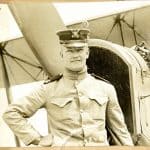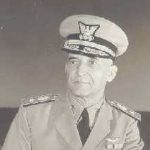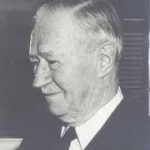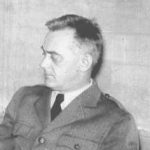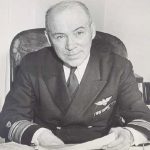The United States entered World War I during April of 1917. There was a small group of aviation pioneers that had promoted and nurtured the early growth of Naval Aviation but the Naval Air establishment was too small and was not equipped for combat operations. There was only one air station, a training base at Pensacola, 54 non-combat training aircraft, 48 aviators plus a small number in training, and 239 enlisted personnel. Between the declaration of war and the signing of the Armistice, a period of 19 months, growth was remarkable and at times chaotic. Air stations were established on both sides of the Atlantic. By wars end, there were 27 bases in Europe, two in Nova Scotia, Canada, one in the Canal Zone, one in the Azores and 12 in the United States. Training programs were established at new air stations, on university campuses, and with private contractors. The navy trained 3,049 aviators and 43,452 enlisted personnel. In addition, there were 2000 aircraft and 15 lighter-than-air craft added to the inventory.
The Coast Guard had made arrangements to send two officers to naval flight training during 1916. The officers were 3rd Lieutenant E.F. Stone and 2nd Lieutenant C.E. Sugden. They were followed by four additional Officers and three enlisted men who were assigned to flight training in late 1916. On 7 April 1917, the Coast Guard was transferred to the Navy Department for the duration of the war. Stone was designated a Naval Aviator on 10 April and was closely followed by Sugden. The first contract for base construction along the Atlantic Coast was let on 14 June. In the interim Stone and Sugden were utilized as flight instructors at Pensacola.
Very few regular Navy officers were assigned to flight training due to fleet requirements. This was also the case with the Coast Guard. It was planned to send nine additional officers to flight training but they too were needed to man the cutters. The vast majority of aviators, aviation ground officers, and enlisted specialist were produced by the Naval Reserve Flying Corps. Recruitment for the USNRF took place on college campuses and from among qualified civilian pilots. Initially, there were a few enlisted pilots almost all of whom were later commissioned. This practice was discontinued and replaced by a program commencing in the summer of 1917, whereby enlisted personnel with “officer potential” were selected for flight training, discharged from the Navy, and then commissioned in the USNRF and upon completion of flight training were designated Naval Aviators. As a result of these procurement programs, the Coast Guard officers were senior to most of their Navy contemporaries. Additionally, previous duty assignments as Revenue Cutter Officers provided the operational experience that was both desired and required by the fledging naval air arm. This resulted in their being assigned as commanding officers of air stations or to other significant duties.

1st Lieutenant Stanley V. Parker USCG took the regular seaplane course at Pensacola and then took lighter-than-air training. From Pensacola, he was ordered to establish and command the Naval Air Station, Key West, Florida, which carried out anti-submarine patrols. In addition 500 Naval Aviators were qualified under his command. From August 1918 until July 1919, he commanded the Naval Air Station Rockaway Beach, New York. This is the location where the NC flying boats were assembled and tested and preparations made for the first flight across the Atlantic Ocean. During 1942 Rear Admiral Parker was Commander of the Third District and was active in persuading the Commandant, Admiral Waesche, that there was merit to helicopter development. Vice Admiral Parker retired September 1, 1947.
Beginning in March 1918, HS-1 flying boats were shipped to France and assigned to U.S. naval air stations. The Naval
Air Station, Ile Tudy, France, 1st Lieutenant C.E. Sugden USCG, Commanding Officer, flew anti-submarine patrol in
HS-1 aircraft. The station was credited with the sinking of three enemy submarines. It was considered one of the most important Air Stations on the French Coast. At the conclusion of hostilities Lieutenant Sugden was authorized to accept the “Chevalier of the Legion of Honor of France.” Captain Sugden retired April 1, 1950.
2nd Lieutenant Eugene A. Coffin USCG, after his designation as a Naval Aviator, was assigned as Commanding Officer of newly enlisted recruits at Pensacola. In December of 1917, he was transferred to the Naval Air Station Montauk Point where he served as a patrol plane pilot and was placed in charge of developing the communications system. On 28 August he was assigned as the Executive Officer of Naval Air Station Rockaway, N.Y. under the command of Captain Stanley V. Parker USCG. Rear Admiral Coffin retired April 1, 1950
1st Lieutenant Phillip B. Eaton USCG, upon being designated a Naval Aviator, was assigned as Commanding Officer of the Naval Air Station, Chatham, Massachusetts. During the late spring and summer of 1918, the German Navy stepped up submarine attacks on shipping off the East Coast of the United States. On July 21, 1918, a surfaced German submarine was firing on a tugboat and three barges off Cape Cod. It was attacked by two seaplanes from NAS Chatham. Lieutenant Eaton, who regularly took patrol flights, made his approach and dropped two bombs. One landed on the submarine and the other close to the submarine’s hull. Neither bomb exploded and the submarine submerged and escaped. Eaton did prevent the sinking of the tug and barges. Rear Admiral Eaton retired August 31, 1946.
There were three different schools of thought within the naval air establishment on the preferred means of taking air power to sea. The long-distance  flying boat would prove very impressive as the design progressed from the HS-1 through H-16 and the British F5L, leading to the Curtiss NC aircraft. All had the mark of Glenn Curtiss. The lighter-than- air people pointed to the success of the upgraded DN-1 and dirigibles obtained from the French in March of 1918. Goodyear produced the B model non-rigid dirigibles followed by the much improved C models but it was not until 1919 that the Navy Airship Program was authorized and LTA became a significant segment of Naval Aviation. The third group was of the opinion that aircraft should fly from combatant ships of the fleet.
flying boat would prove very impressive as the design progressed from the HS-1 through H-16 and the British F5L, leading to the Curtiss NC aircraft. All had the mark of Glenn Curtiss. The lighter-than- air people pointed to the success of the upgraded DN-1 and dirigibles obtained from the French in March of 1918. Goodyear produced the B model non-rigid dirigibles followed by the much improved C models but it was not until 1919 that the Navy Airship Program was authorized and LTA became a significant segment of Naval Aviation. The third group was of the opinion that aircraft should fly from combatant ships of the fleet.
On July 12, 1916, Lieutenant G deC Chevalier was launched from the first catapult designed for shipboard use aboard the Armored Cruiser North Carolina. In April of 1917, the Armored Cruiser Huntington was at the Mare Island Navy Yard for the installation of a catapult of the type installed on the North Carolina. The Huntington arrived in Pensacola on May 28, 1917, for a series of tests and evaluations. 3rd Lieutenant E. F. Stone USCG, 3rd Lieutenant Robert Donohue USCG, and CAP C.T. Thrun USCG were ordered aboard as part of a nine man aviation detachment. Lieutenant Marc Mitscher USN had reported aboard at Mare Island as Senior Aviator. The commanding Officer of the USS Huntington, Captain J.R. Robinson was not favorably disposed to having an aviation detachment aboard his ship. The first plane went aboard in June but very little was done with it. When evaluations were made the aviation detachment personnel were not consulted. On one occasion the Captain attempted to drop a seaplane into the sea with the ship moving in much the same fashion as a whale boat on a painter. He reasoned that the aircraft would then take off from the water making the installation of the catapult unnecessary. When the aircraft made contact with the water it promptly flipped over and was wrecked.
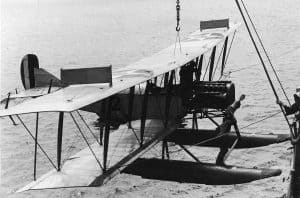 In late July Mitscher and crew received the new twin float R-6 seaplanes. He got his planes and stores aboard. On 1 August the Huntington departed for New York and was assigned to lead a convoy into the Atlantic. The Planes were dismantled, put below and never flown. There was a flaw in the catapult design in that each time the catapult was used the catapult carriage car was lost over the side. When the ship returned to New York in October, the aviation detail and aircraft were transferred ashore and the catapult was dismantled. Stone solved this problem years later when he invented the powder catapult, which became the Navy standard on cruisers and battleships.
In late July Mitscher and crew received the new twin float R-6 seaplanes. He got his planes and stores aboard. On 1 August the Huntington departed for New York and was assigned to lead a convoy into the Atlantic. The Planes were dismantled, put below and never flown. There was a flaw in the catapult design in that each time the catapult was used the catapult carriage car was lost over the side. When the ship returned to New York in October, the aviation detail and aircraft were transferred ashore and the catapult was dismantled. Stone solved this problem years later when he invented the powder catapult, which became the Navy standard on cruisers and battleships.
Lieutenant Elmer F. Stone was transferred from the aviation detail aboard the USS Huntington to the Bureau of Construction and Repair where he became the chief test pilot for seaplanes in the aviation division. Lieutenant Stone, at the Navy’s request, was assigned duties in support of the Navy during the next nine years. In addition to being the Pilot of the NC-4 for the first Transatlantic Flight, he led in the development of shipboard catapults and aircraft carrier catapults and arresting gear. Commander Stone died when suffering a coronary thrombosis attack while assigned as Commanding Officer of Coast Guard Air Patrol Station San Diego May 26, 1936.
2nd Lieutenant Donohue was transferred from the aviation detail aboard the USS Huntington and assigned duties as Commanding Officer of the Naval Air Station at Sydney Nova Scotia, Canada. He then became Commanding Officer of Naval Air Station Montauk Point, New York and became involved in lighter-than-air aircraft. He provided flight test support for the C-5 dirigible that made an unsuccessful attempt to complete a Transatlantic Flight. Rear Admiral Donohue retired June 1, 1946.
The Coast Guard did not return to the jurisdiction of the Treasury department until August 28, 1919. This was accomplished with much controversy. The Navy wished to retain the Coast Guard and a large portion of the Coast Guard Officer Corps favored this course of action. Coast Guard aviators had served with distinction during the war and several continued to serve with the Navy for a period after the armistice. Lieutenant Elmer F. Stone added to Coast Guard aviator reputation by piloting the Navy’s large NC-4 flying boat on the first transatlantic flight in May 1919. The continued existence of Coast Guard aviation as an entity became critical upon the return to the Treasury Department.
Evolution of the Rank Structure of the Coast Guard:
The Coast Guard came into being on January 28, 1915, and the new service attained full military status. Neither the Life-Saving Service nor the Revenue Cutter service had this distinction. Modifying legislation, signed into law the following year, specified that when the Coast Guard was serving with the Navy, precedence between commissioned officers in corresponding grades in the two services would be determined by the date of commissions in those grades. There existed, however, a disparity in the opportunity for promotion within the Coast Guard when compared to that of the Navy Officer. The Coast Guard had only one Officer, the Captain Commandant, who ranked with Captains in the Navy. For practical purposes, the highest rank a Coast Guard Officer could aspire to was that of Coast Guard Captain, which corresponded to a Navy Lieutenant Commander.

